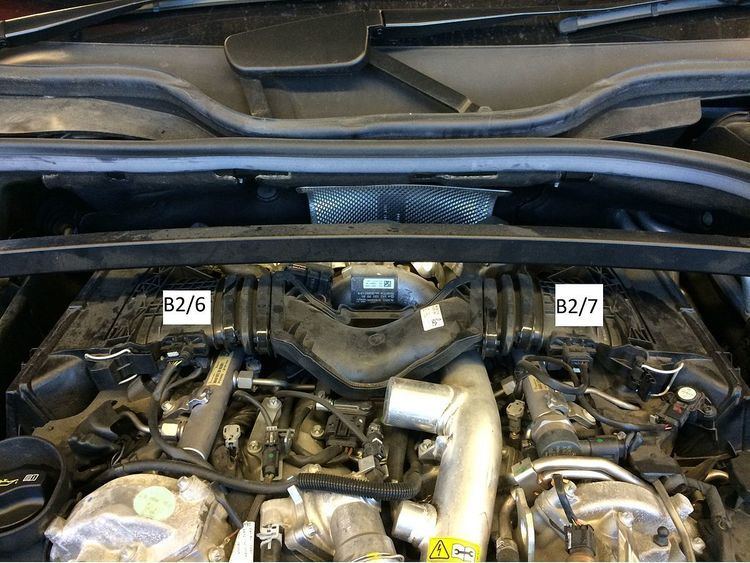Manufacturer Daimler AG Displacement 2,987 cc (182.3 cu in) Piston stroke 92 mm (3.6 in) | Production 2005- Cylinder bore 83 mm (3.3 in) Cylinder block alloy Aluminium/Aluminium | |
 | ||
The Mercedes-Benz OM642 engine is a 3.0-liter, 72° 24-valve, aluminium/aluminium block and heads diesel V6 engine manufactured by the Mercedes-Benz division of Daimler AG as a replacement for the Mercedes-Benz inline straight 5 and straight 6 cylinder engines.
Contents
The engine features common rail fuel injection and a variable nozzle turbocharger. The injection system operates at 1,600 bar (23,000 psi), while the compression ratio is 18:1. The engine features a counter-rotating balance shaft mounted between the cylinder banks to cancel the vibrations inherent to the 72 degree V6 design, and the crankpins are offset by 48 degrees to achieve even 120 degree firing intervals. In some heavy vehicle applications, Mercedes' BlueTec AdBlue urea injection is utilised for NOx reduction. In lighter vehicle applications, a NOx storage catalyst captures nitrous oxides, which are periodically purged (decomposed) by running the engine slightly rich. A particulate filter lowers soot, making this engine ULEV certified. Engine mass is 208 kg (459 lb). Power output is 165 kW (224 PS; 221 hp) and 510 N·m (380 lb·ft) of torque. For the 2007 model year, torque is raised to 540 Nm.
Implementation
Vehicles using this engine include:
1 EMEA 2 North America
Production
The engine is manufactured at the Daimler AG plant in Marienfelde, Berlin, Germany.
Due to the inordinate number of pre-2010 OM642 engines needing repair due to heat-related seal degradation causing oil cooler leaks, Mercedes reformulated the seals from an orange color rubber to a purple color Viton seal now used in all 2010 and later engines. There is a Mercedes Technical Service Bulletin that states that the leak can be attributed to an improperly installed seal. This engine also has an inherent design flaw with the TWC temperature sensor (part no. A005 153 40 28) and the part in the electronic parts catalog is now specifying part no. A007 153 74 28; there is no recall on this service item yet. A check engine light may present with the OBD-2 diagnostic code P2031 upon failure of this sensor.
Oil specification MB 229.51 or MB 228.31 is recommended, for the bluetec engine in the G w463, GL x164 and Ml w164 the oilspec. is 229.52 class.
In addition to the oil cooler seals; this engine can also have an issue with the design of the positive crankcase ventilation system. The crankcase ventilation system vents to the inlet of the turbo. The issue is that the air vented from the crankcase contains too much oil to easily pass through the swirl motor valves downstream of the turbo. Once this oil and sludge begin to accumulate, the valve becomes inoperative and blows a fuse that controls many other sensors required to properly operate the engine and emission system. This will immediately place the vehicle into limp home mode and limit the rpm to 3000. It also causes a check engine light and numerous OBDII Codes. Mercedes Benz has previously recognized this feature of the vehicle and has stated that this engine feature, the accumulation of oil at the turbo inlet, is "normal". In a Technical Service Bulletin they issued in 2008 they state: "Engine oil venting occurs on the right hand side of the engine air intake duct. For this reason there is always some oil in the engine air intake duct, see (Figure 3). This is no justification for replacing the turbocharger. Turbochargers replaced for this reason will not be covered by warranty." While a slight amount of oil may be normal and acceptable, sufficient quantities and accumulation will indeed lead to other failures as identified above.
Honeywell Turbo Technologies produced the turbochargers used in the 2011 Mercedes S 350 BlueTec engines.
The glow plug controller is known to malfunction on these engines. There are several vehicle applications that use either 4-volt or 7-volt glow plugs. It is at present difficult to ascertain the output voltage of various suppliers' replacement modules. The Dorman 904-310 seems to output 7 volts. There are some year models of Jeep that require a module output for the 4-volt glow plugs installed on those models. The 2008 Mercedes E320 Bluetec has the NGK CZ 302 glow plug (replaced by NGK CZ 303) that require 7 volts.
Intake System
Air is drawn into the engine through two air filters located above each cylinder head. The amount of the air is metered by two hot film mass air flow sensors B2/6&7. On Sprinter models, a single air filter housing is mounted upon brackets on top of the engine.
The variable geometry Kompressor is actuated via a linkage connecting the controller to vanes inside the Kompressor housing. In the full-boost position, air is allowed to pass over the Kompressor impeller. In the no boost position the vanes block exhaust gasses from acting on the impeller and route them down the exhaust pipe.
